
While AI has been on the radar for the last few years, ChatGPT, an artificial intelligence tool developed by OpenAI that uses a neural network to generate language, has exploded recently after being launched publicly in November of last year.
It has felt as though it’s taking over our newsfeeds, and social focal points in tech, and causing us to question, “Will my job be replaced by AI?”.
From using it to cheat to write academic papers for students, offer salary negotiation advice, generate unique content ideas, and write music and code, we are finding more and more practical applications to help us in our day-to-day lives.
People all over the world are testing both its capabilities and limits, such as, “Could ChatGPT earn a Wharton MBA?”, or the 22-year-old that developed GPTZero, an app that can decipher whether writing is machine or human-generated, but in the words of Solopreneur Justin Welsh, “You have to master natural intelligence before artificial intelligence becomes useful.”
What does ChatGPT mean for product managers?
One practical application? Use it to help with roadmap planning through automation assistance, acting as a creativity catalyst, and aggregate organizer.
Roadmap planning - the action of figuring out what items should be considered to be part of your team’s focused areas of work, and when (i.e. Now vs. Next vs. Later), to improve customer and business outcomes - is an essential part of bringing any product idea from concept to market.
If every stakeholder on a team (including external customers and partners) were part of an original telephone system, the product manager’s role would be that of the telephone operator - to connect all of the inputs (telephone calls or ideas for development) and map them to how to achieve the desired outcomes (i.e. successfully placed calls or a tangible value added for customers and the business).
A roadmap is the best tool in your arsenal to effectively communicate this and “light the way” for the team.
Before even considering plugging AI into what you’re working on, you’ve got to use your human intelligence to define your specific desired outcomes. Namely:
What is the larger context your roadmap is fitting into (i.e. problem space, company mission, product vision, product strategy, competitive landscape)?
What constraints are you dealing with (i.e. time, resources, regulatory constraints)?
What does success look like for your organization (i.e. Revenue, Customers, Engagement)
How will you fare in these five risk categories (initially coined by Marty Cagan - The Four Big Risks - and I’ve added a fifth):
Value: Whether customers will buy it or users will choose to use it
Viability: Whether this solution also works for the various aspects of our business
Usability: Whether users can figure out how to use it
Feasibility: Whether our engineers can build what we need with the time, skills, and technology we have
Ethics: Whether our product violates basic human moral principles
Once you’ve adequately framed your roadmap, exploring using AI in these ways may help when figuring out what and how to collect, organize, and prioritize information to include to help get your team from where you are now, to where you want to be.
A Very Important Note: As Welsh points out above, we need to master natural intelligence as a starting point. I would never use ChatGPT or AI tools as the gold standard or sole input. Always build the information gleaned from these tools into your larger context that only you can piece together adequately. Put another way, every output from AI should be teamed with a human “Edit” function.
Using AI for Roadmapping
1. Competitive Landscaping, Trends, and Market Research: For example, say you’d like to better understand the general landscape in a particular problem space as a context for your roadmap. You can use ChatGPT to augment and add to the work you can do individually and as a team to get a more holistic picture of the situation:
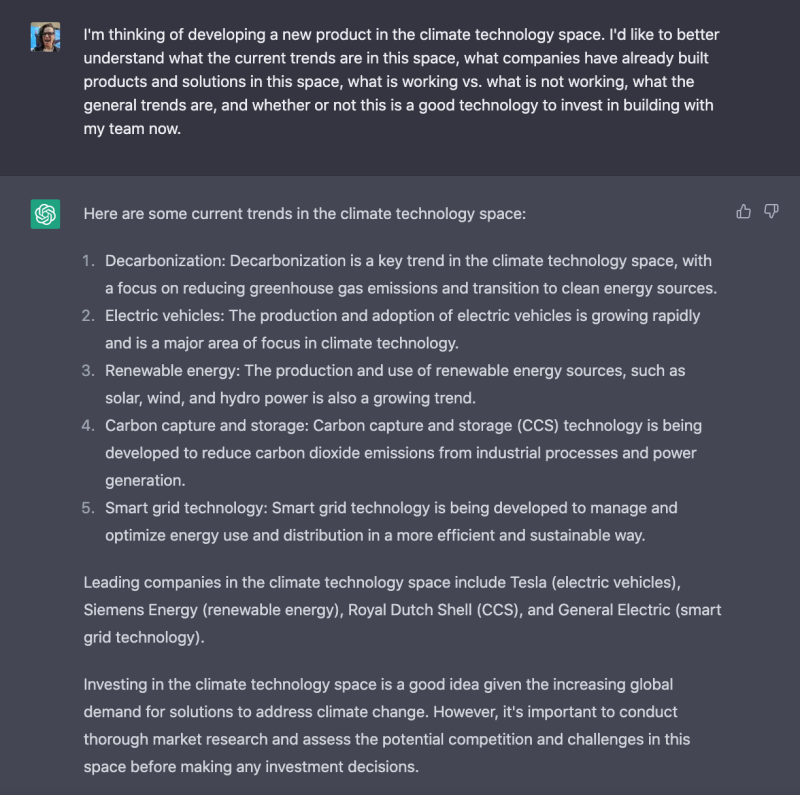
2. Idea Generation: For example, say you are working at a wearable technology company and one item on your roadmap is most definitely going to be a method whereby users can size themselves in order to purchase a product that fits them and limit returns (I lived through this exact example). You can use ChatGPT to generate ideas to help give you prompts and suggestions that you may not have come up with on your own or with your team:
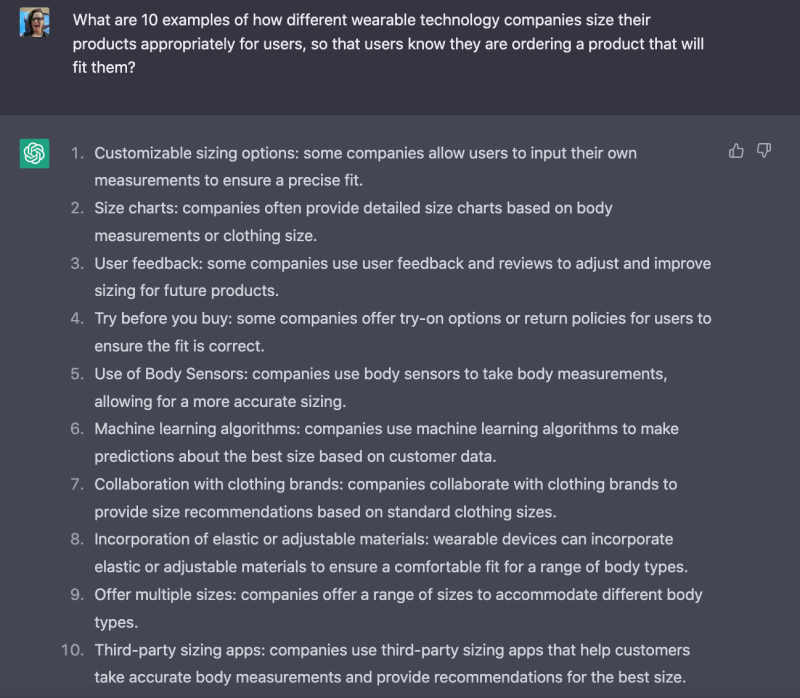
3. Task Prioritization and Forecasting: For example, say you are working on v 1.0 of a new product that will be first to market and you’re not entirely sure how to prioritize the work involved. You can feed ChatGPT relevant information, like your problem space, what you are trying to accomplish, your resources, your timeline, and any other known constraints and glean this for input on how to prioritize your roadmap.
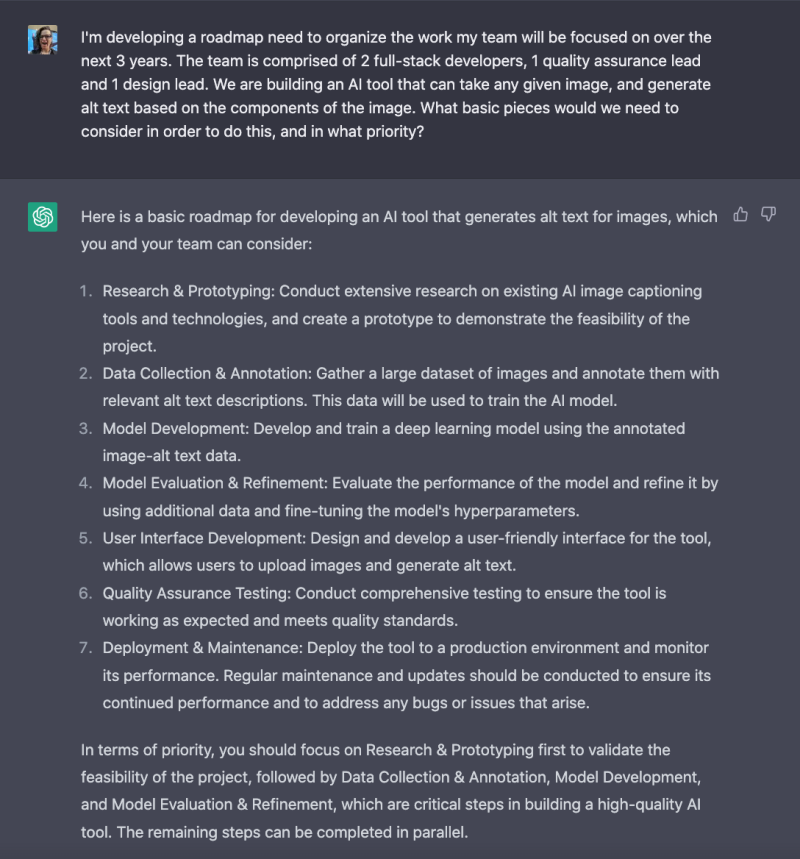
4. Conducting SWOT Analysis: For example, say you want to make sure your roadmap is positioned to incorporate your current strengths, weaknesses, opportunities, and threats. You could use ChatGPT as a starting point to start to outline what to consider under each category:
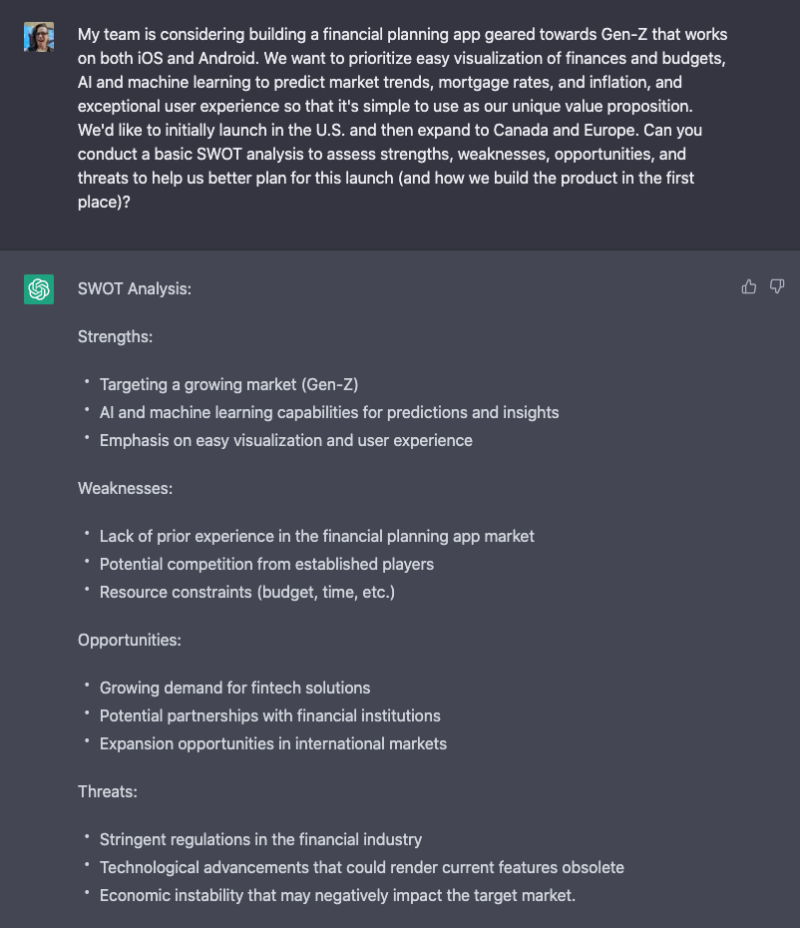
(I also adjusted this one to give me an actual list of competitors in this space):
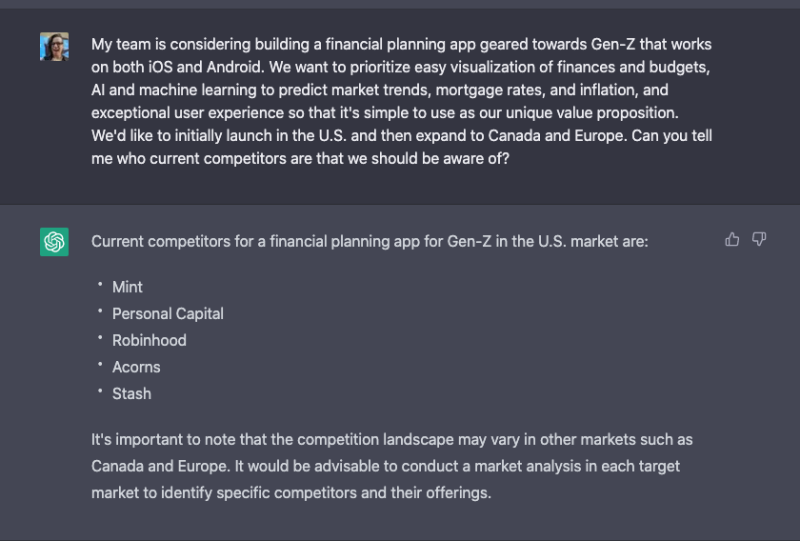
5. Identifying Dependencies: For example, say you want to identify and assess dependencies as part of roadmap planning. You could speak directly with your engineering and design teams and also use ChatGPT as inputs to help you to understand specifically what you need to be thinking about and why across your product, platform, distribution channels, etc.:
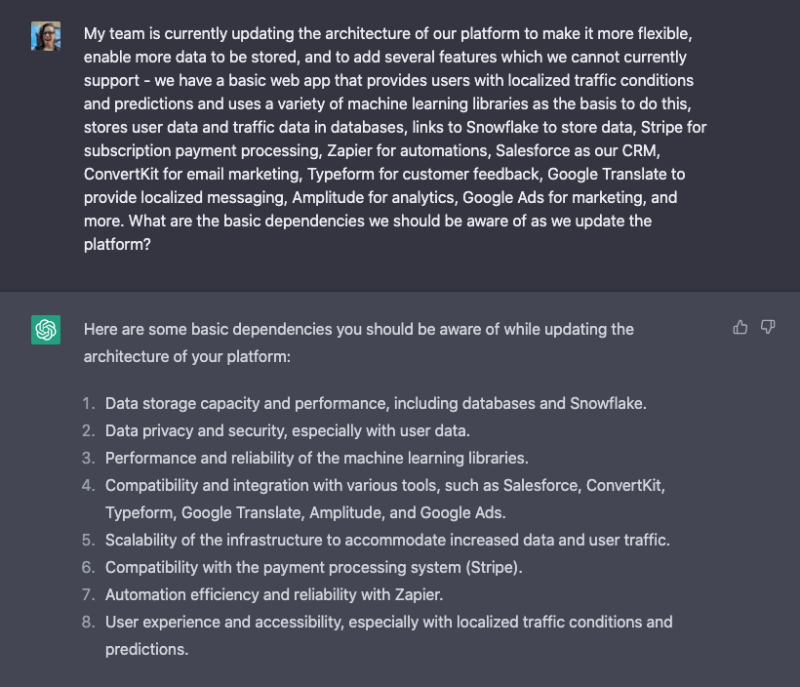
6. Communicating and Updating Your Roadmap: For example, say you’re getting ready to present your roadmap to a larger group of stakeholders to gather their feedback and input to improve it. You can use ChatGPT to help give you ideas about how to structure this to communicate effectively depending on what your goals are, here is a part of the flow:

…and also use tools like OpenAI’s DALL・E 2 that can help you create realistic images and art from a description in natural language to help you paint a picture of the future you are aiming to create with your roadmap.
For example, by inputting in DALL-E 2, "A person putting garbage in a car gas tank as fuel" I got:

Use Cases for AI in Roadmap Planning
Product managers are already using AI in their roadmap planning. Here's how they're using it:
Predicting customer needs
AI can analyze large amounts of customer data, including demographic information, purchase history, and feedback, to identify patterns and predict future needs. This can help companies anticipate what their customers may want in the future and tailor their products and services accordingly. For example, a company may use AI to analyze customer data to identify which features are most important to customers and then prioritize those features in their product roadmap.
Identifying market trends
AI can analyze large amounts of market data, including competitor offerings, consumer behavior, and industry trends, to identify patterns and predict future trends. This can help companies stay ahead of the curve and adjust their roadmap to capitalize on emerging opportunities. For example, a company may use AI to analyze market data to identify which emerging technologies will likely have the most significant impact on their industry and then incorporate those technologies into their roadmap.
Generating text to describe parts of the roadmap like features and milestones
AI can generate natural language descriptions of product features and milestones, saving time and improving the consistency and quality of these descriptions. For example, a company may use AI to generate descriptions of product features based on input from engineers and product managers, which can then be used to populate the product roadmap. This can free up valuable time for the product team, allowing them to focus on more strategic activities.
AIs that use natural language processing can generate great descriptions of product features and milestones based on input from engineers and product managers. This can help ensure that descriptions are consistent and high-quality and save time for the product team. Additionally, some AIs, like ChatGPT, can generate language that is optimized for SEO, which can help improve the visibility of the company's roadmap and increase traffic to the company's website.

AI roadmap planning example
A good product manager will take all of the above use cases for AI in roadmap planning and combine them for maximum value. Let’s look at how that process would go for a new food delivery app:
We could start by using AI to gather insights about the current customer reviews of existing food delivery apps. We can identify the customers' common pain points and expectations by analyzing customer feedback from various platforms like app stores, social media, and review websites. We can also leverage sentiment analysis to understand the customers' feelings towards different features and services these apps offer. This information can help us identify gaps in the market and opportunities to differentiate our product.
Next, we can ask our AI to create a comprehensive list of current food delivery apps in the market that we want to enter. This will give us a simple way to see all our competitors’ app store scores and reviews. This lets us quickly identify the key competitors and their features, strengths, and weaknesses. We’ll then use the information to help us develop a unique value proposition and differentiate ourselves from the competition.
Next, we’ll use AI to automatically generate text for points on our product roadmap. This can include features such as real-time delivery tracking, personalized recommendations based on user preferences, and advanced search filters to find specific cuisines or dietary restrictions. We can generate an easily understandable and comprehensive roadmap using natural language generation.
Finally, we can also use AI to generate a sample timeline for our product roadmap. This can include estimates for the development of different features and the expected launch date for the app. Using machine learning models, we can generate a timeline that considers development time, resource availability, and potential risks.
The risks of using AI for roadmap planning
While there are many pros to using AI to help during roadmap planning, including market research, idea generation, task prioritization, SWOT analysis, dependency identification, they don’t always come at no cost.
What are the dangers of using AI to help product teams plan roadmaps? I started formulating my response but then thought - why don’t I go directly to the source:
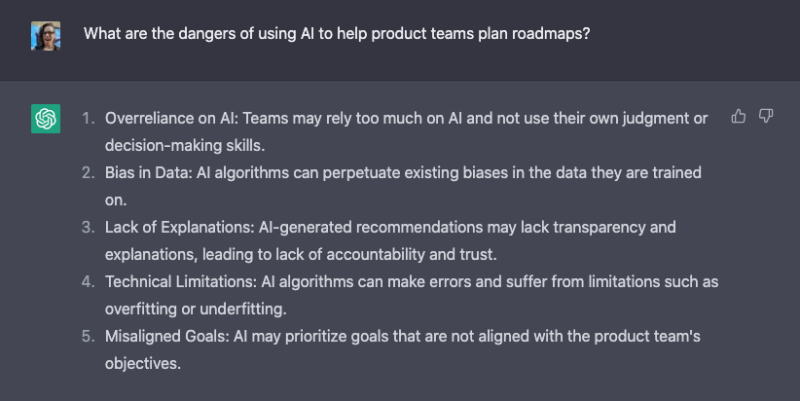
As we have seen in many areas of AI, the list of shortcomings is not small. Specifically dangerous in my opinion is #2- we are often blind to the bias that is encoded in AI algorithms (as shown in the powerful documentary Coded Bias) which can dramatically impact results and real-world implications.
Any technology that we bring into our lives amplifies our abilities - in both positive and negative ways - and I don’t personally believe we are at a point yet where we’ve established enough guardrails in AI to emphasize the “for good” parts of this technology while limiting the “for evil” portions.
While AI and specifically new tools like OpenAI’s ChatGPT and DALL・E 2 are exciting and new, we must use them with a grain of salt. Always think critically about the responses generated and how to incorporate them in your day-to-day workflows.
You can try out AI Assist from airfocus now for free. Explore for yourself the power of AI in product management, with a tool that can help you all the way from PRDs and problem statements to new product ideas. All with just a slash command.
Lisa Zane

Read also



Build great roadmaps

Experience the new way of doing product management




